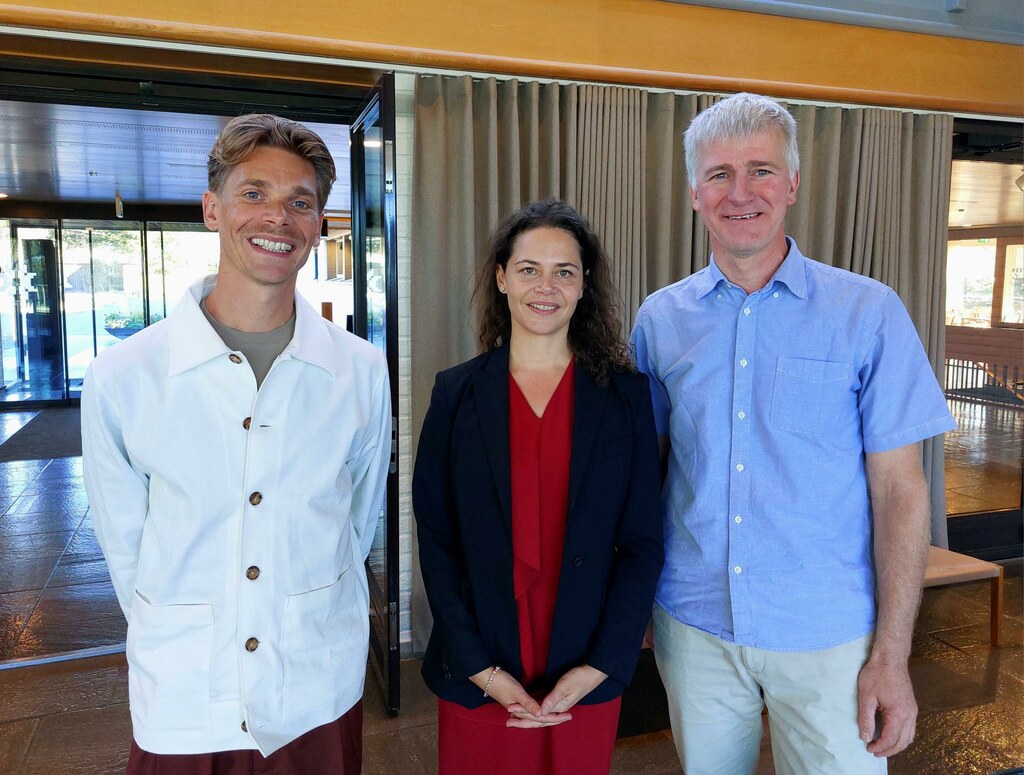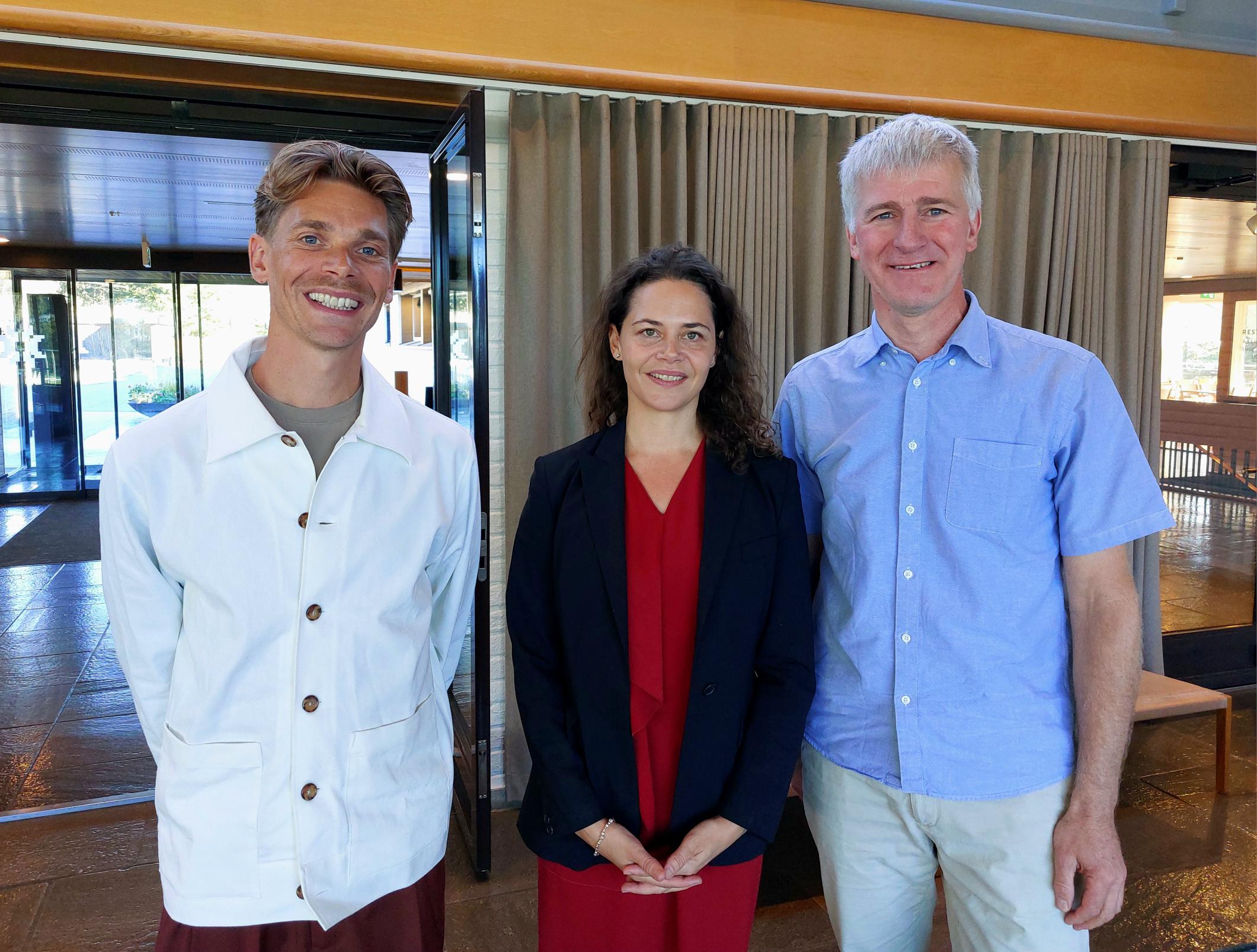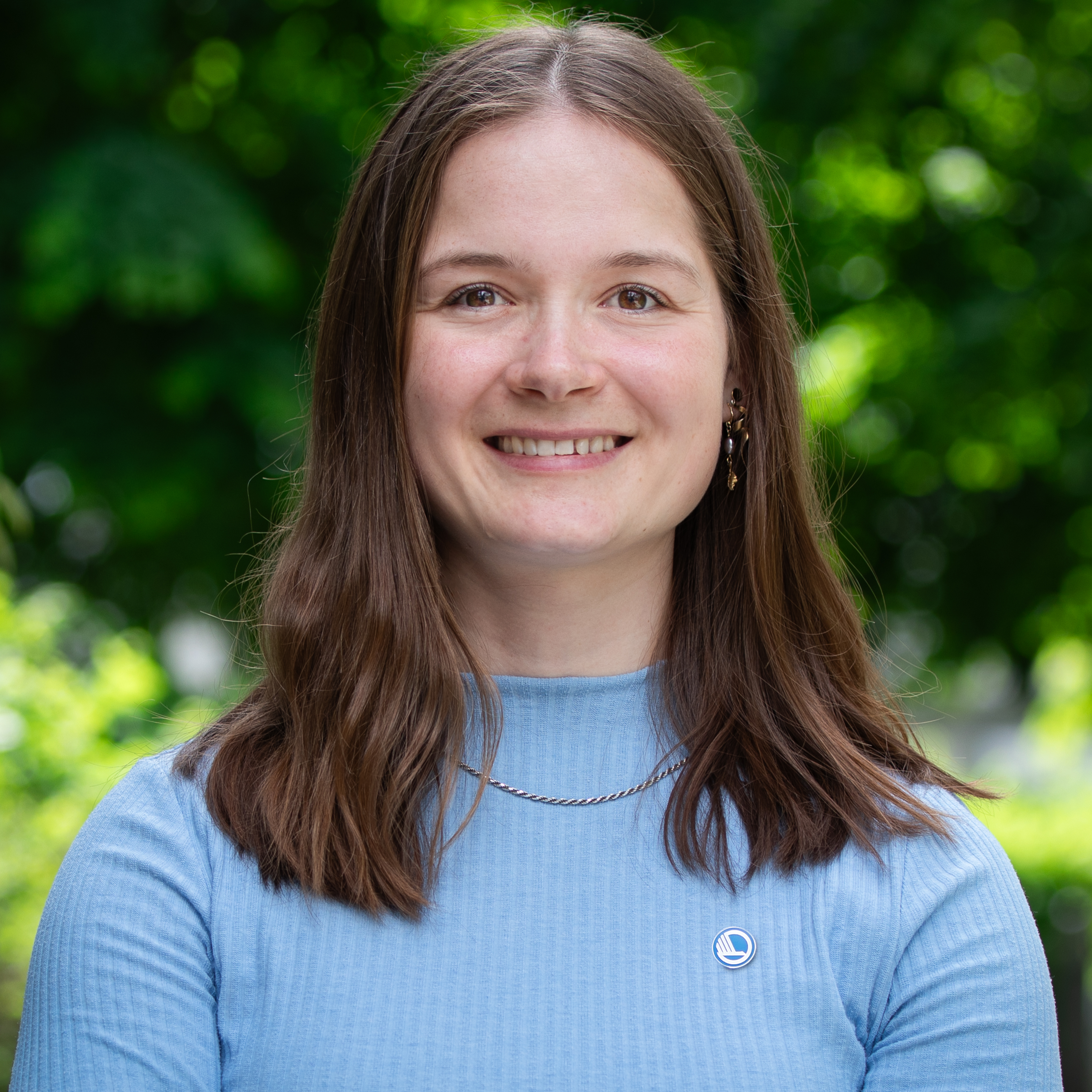
“A Nordic way of doing the energy transition”
On 3 October, the winners of the Nordic Energy Challenge 2024 were presented at the Annual Mobility Workshop in Oslo. This year, the first place was shared by two project proposals for…
On 3 October, the winners of the Nordic Energy Challenge 2024 were presented at the Annual Mobility Workshop in Oslo. This year, the first place was shared by two project proposals for the first time ever.
Nordic Energy Research is pleased to congratulate both the duo Julia Kirch Kirkegaard and Tom Cronin, and the KXT Team, lead by Rune Kirt! Shortly after their names were announced, we had the chance to sit down with the winners, while their win was still fresh news.

Rune Kirt, CEO, Design Architect, and Co-founder of KIRT x THOMSEN, Julia Kirch Kirkegaard, Associate Professor, and Tom Cronin, Senior Adviser at DTU Wind and Energy Systems.
What was going through your minds when you were announced as this year’s winners?
“The quality of our video… We looked like old-fashioned teachers!” says Tom.
“It was done in a bit of a hurry, but I guess we didn’t really expect to win, although we are very grateful and proud,” says Julia.
“Yes, I think that was my first thought – being proud. I didn’t have any expectations either, but really taking it step by step – from handing in the abstract, to us being the only two left after the third-place announcement,” says Rune.
How are you going to celebrate the accomplishment?
“I need to inform my teammates, so the next level of celebration is to share the win with them,” says Rune. “But it’s also a celebration of the approach,” he continues.
“Yes, another side to the celebration is that the aspect of citizen engagement is acknowledged, and that people can see value in what we’re doing,” says Tom.
“In addition, we hope to follow up on our idea within the SpeedLocal project, where the both of us are actually involved,” says Rune.
“We should celebrate together in SpeedLocal!” says Julia.
Speaking of your co-involvement in SpeedLocal, the jury encouraged you to collaborate in the future to maximise each other’s competencies. What happens next?
“We are already sort of collaborating through the SpeedLocal project, where we will have co-creation workshops. I think that the KXT Team’s idea of visualisation is inspiring and important, because we’re struggling to find out how exactly to engage diverse actors. People come from many different backgrounds and do not necessarily relate to e.g., economic discourse. We need other ways of communicating and visualisation can play a huge part in that,” says Julia.
“Our proposals do supplement each other very well, so I believe it makes super good sense to collaborate,” says Rune.
Why did you decide to take part in this challenge?
“I saw it advertised on LinkedIn and the theme spoke to me and my research, so I thought ‘why not?’ We’ve been working across disciplines for many years now – Tom is an engineer and I’m a social scientist – so it was a good way to check if people would see the value in this kind of interdisciplinary work,” says Julia.
Tom agrees.
“Interdisciplinary work is something that’s talked about a lot. In academia, there’s quite a lot of literature on it. But actually doing it is something else. That’s the exciting opportunity that the Nordic Energy Challenge offers – a place where this sort of thinking can be out into action,” he says. “Also, I’m very happy about the challenge’s focus on citizen engagement. Because at this moment, people aren’t aware of which values are excluded. And when these values suddenly have a say, it’s not until right in the end, when there’s no room to accommodate them. Therefore, I’m pleased that this matter is taken more seriously and earlier.”
“I noticed the challenge in Nordic Energy Research’s newsletter, where I’ve seen inspiring challenges from earlier years. However, I found them too technical to apply. But then there was this one, which embraced ‘softer’ approaches and a movement from STEM towards STEAM. You need to have the A in the abbreviation, as more Arts based methods can open up the harder fields, spur new ideas, and help us get a better understanding of engagement,” says Rune.
“And if we’re talking about next next steps, I definitely see that this approach comes from the DNA of the Nordics – having a dialogue and a more flat structure in disciplines. I think that this is something that can go outside the Nordics as well. Maybe not next year, but still within a foreseeable future,” Rune continues.
“Yes, a Nordic way of doing the energy transition in a just way. Other regions in the world can take notice,” says Julia.
What would you say to other, future applicants in the Nordic Energy Challenge?
“Just do it!” Julia and Rune say at the same time.
“I would also suggest thinking a bit wild and make sure that your proposal has an edge. Consider why the proposal stands apart from the others. With that in mind, maybe you can at least inspire others,” says Rune.
Third place
Nordic Energy Research would also like to congratulate Xiaolei Bian and Changfu Zou on their third place for their idea “ChargeForward: Empowering citizens with AI to enhance battery health and sustainability”. We got hold of Xiaolei after the winners’ ceremony at the Annual Mobility Workshop for a comment.
“Thank you to Nordic Energy Research for this opportunity – that I could come here to make new friends and network within the energy research field. I have already talked about common research interests with people here, and we may have opportunities for collaborating projects to push the boundaries for new knowledge and technologies in the future,” says Xiaolei.
Motivation of the jury
Julia Kirck Kirkegaard, Associate Professor, and Tom Cronin, Senior Adviser, at Technical University of Denmark
Proposal title: “Inventive tools for public participation in the design of an integrated Nordic Energy region”
Julia’s and Tom’s winning proposal demonstrates a planning tool that incorporates social parameters for the feasibility assessment of large-scale renewable energy projects. This tool has been developed based on workshops and through a comparative study of Nordic and Baltic design and planning approaches for renewable energy projects. It has provided a comprehensive overview of tools for including citizens and ensuring that social impacts are considered for comprehensive energy projects.
By encapsulating the early-stage development of Green Energy Islands in the Nordics, the proposal arrives just in time to ensure that the public can have a voice in the significant intervention of our energy supply chains for the future.
The jury hopes that the project will have a real impact and that lessons learned from onshore renewable energy projects can be applied to the sustainable planning of offshore large-scale renewable energy projects where citizen engagement is prioritised.
Rune Kirt and his team of five from Kirt X Thomsen, Denmark
Proposal title: “Art + Green Tech – Design-Led Methodology for Inclusive Energy Transition”
The KXT Team’s winning proposal supplements the first one to a high extent. Both proposals embrace the crucial need for engaging citizens in large-scale renewable energy projects.
This proposal introduces a tool for simplifying the complexity of new renewable energy projects through visualization and digital arts, designed in a co-creative process involving different stakeholders, including local citizens and municipalities. In addition to making renewable energy projects easier to understand, the proposal aims to create a sense of ownership by involving citizens in project design to mitigate local resistance.
The jury expressed satisfaction with the approach, as current research has identified successful results by engaging citizens in the design phase. They hope to see this method applied on a Nordic scale to enhance the proposal’s Nordic added value.
Given the clear connections between the two winning proposals, the jury encourages the projects to collaborate in the future to maximise each other’s competencies.

